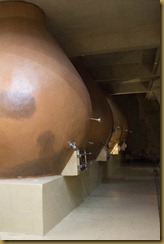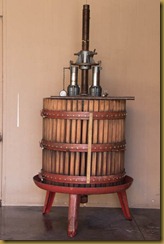Day 4 – Casablanca Valley
Many museums and other attractions in Santiago are closed on a Monday, which was the perfect excuse to book ourselves on a wine tour out to one of the valleys near the city. It was $195 USD per person so a bit of an extravagance, but I think we got our money’s worth.
Our guide, Andrea from Uncorked, picked us up promptly at 8:50 and we set off on the roughly one hour drive northwest. On the journey Andrea filled us in on a mixture of topics ranging from history, culture, climate, geography and of course wine. All in flawless English and with a lovely, fun twinkle in her eye. We couldn’t have asked for a nicer guide. We were also the only ones on the tour so had plenty of room to ourselves.
The Casablanca region used to be cow country, much like Margaret River. It is primarily granite soil and the temperature ranges widely during the course of the day from cool mornings to mid thirties in the afternoon, making it great for some of the cool climate wines like sauvignon blanc, chardonnay and pinot noir. Once you’re through the tunnel you feel the difference in temperature to Santiago immediately. The climate is impacted by the Humboldt current, bringing cool water up from the Antarctic and rainfall to the coastal areas in the south of Chile.
The region is relatively young, with vines only being planted in the 1980s. The first winery we visited is the lastest venture by the man who first started to grow grapes at Casablanca, Don Pablo Morandé. Bodegas RE is a boutique winery with a very clear and delightful philosophy. They focus on bringing together the old and the new with techniques long abandoned and now recently rediscovered. This includes the use of clay and concrete pots for fermenting wine.



The cellar door and showroom is outfitted with some charming antiques, the floors are old railway sleepers and the building is designed to work with the climate of the area so they don’t need to use air conditioning. Mum would love this place.
We tasted a new wine we’d never heard of before, carinena. My favourite wine of the day, and possibly the nicest wine I have ever tasted (big, big call so keep in mind this was the first place we visited and only the thrid wine of the day so my judgement was as unimpaired as it could be). The Cabergnan, 2009 was smooth as silk with all the rich flavours you’d expect from a full bodies red. If they shipped to Australia I would have ordered a case. Maybe two.

The red grapes are grown in the Maule valley on vines that are to 160 years old. They are dry farmed, meaning they are not irrigated at all. And they are not grown on trellises, but as bushes, something I’ve never seen before.

Wine tasting here, at least the ones we were treated to on tour, are not the small tastes you pay for at home, but almost full glass paired with bread, cheese, the nicest olives I’ve ever tasted and balsamic and olive oil. No spittoons in sight. The tour of the cellar and the grounds was just as enjoyable at the wine and Bernadette was very informative and entertaining.
Our next stop was the Kingston Family vineyard. Also very nice but much more like any other winery with stainless steel vats. A pretty outlook though. We were joined by a couple form Arizona who were a bit more into their wines than we were.

For lunch we stopped at Viña Quintay. I didn’t catch the names of all the dishes, but salmon ad seafood prevailed, with a cheesecake to finish off. Again, we didn’t need to worry about dinner when we got back.
The other things we learnt about the region is that frost can be a real problem. They used to use the old fashioned method of fires along side the rows of grapes, but because many of the vineyards are next to the freeway, and there is fair amount of fog about, that was soon outlawed. They now use fans to move the air about, the igloo effect by misting about the buds, or helicopters to stir the air and bring the cool air up and the warm air down.
As an Australian traveling I always stress a little about how the tipping works. I end up never known if I’ve tipped too much or not enough. There are some guides out there so I just followed along with the. And went for 10% in most cases, though as lunch was included in the tour price I had to take a wild stab in the dark when leaving a tip at the restaurant. I also didn’t realise you’re meant to tip the girls packing your groceries at the supermarket so I feel bad about that. At least there is no haggling in Chile so that is one less thing to worry about.
The location of our apartment has been amazing. Less amazing is the woeful air conditioning. Craig would not be happy. Seeing as we are only here a few days it wasn’t worth trying to communicate the issues to the poor girl at the well hidden reception, but paired with the very load garbage collection in the street below between 1 and 2 am we haven’t been getting a lot of sleep.
We found out from Andrea that the roads are closed every Sunday for the cyclists and runners so that answers that question.
That completes our time in Chile. It has been lovely and it is on my list of places I’d like to come back to and explore further. Santiago seems to be a city at hat would be easy to live in.
